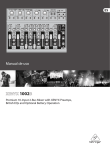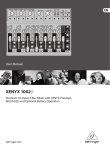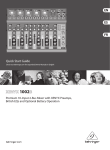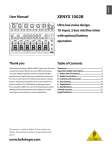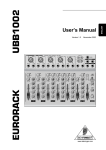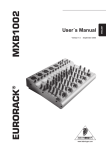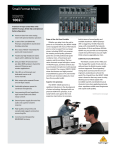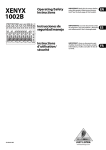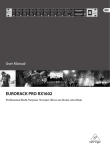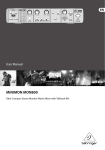Download Behringer XENYX 1002 User manual
Transcript
User Manual 1002 Premium 10-Input 2-Bus Mixer with XENYX Preamps, British EQs and Optional Battery Operation 2 XENYX 1002B User Manual Table of Contents Thank you........................................................................ 2 Important Safety Instructions....................................... 3 Legal Disclaimer.............................................................. 3 Limited warranty............................................................. 3 1. Before you get started............................................... 4 1.1 Shipment................................................................................. 4 1.2 Online registration.............................................................. 4 1.3 Basic operation .................................................................... 4 2. Audio Connections..................................................... 5 3. Controls and Connectors .......................................... 6 3.1 Front panel............................................................................. 6 3.2 Rear panel.............................................................................. 7 4. Gain Setting................................................................ 7 4.1 Using external effects........................................................ 7 4.2 Creating a monitor mix .................................................... 8 4.3 Battery installation.............................................................. 8 5. Applications................................................................ 8 6. Specifications............................................................ 10 Thank you Congratulations! With the PMP2000 you have acquired a state-of-the-art 14-channel power mixer that sets new standards. Right from the start, our goal has been to design a revolutionary device that can be used for a great variety of applications. And indeed, this overwhelming power mixer gives you plenty of functionality and a broad range of connection and expansion options. 3 XENYX 1002B User Manual Important Safety Instructions Terminals marked with this symbol carry electrical current of sufficient magnitude to constitute risk of electric shock. Use only high-quality professional speaker cables with ¼" TS or twist-locking plugs pre-installed. All other installation or modification should be performed only by qualified personnel. This symbol, wherever it appears, alerts you to the presence of uninsulated dangerous voltage inside the enclosure - voltage that may be sufficient to constitute a risk of shock. This symbol, wherever it appears, alerts you to important operating and maintenance instructions in the accompanying literature. Please read the manual. Caution To reduce the risk of electric shock, do not remove the top cover (or the rear section). No user serviceable parts inside. Refer servicing to qualified personnel. Caution To reduce the risk of fire or electric shock, do not expose this appliance to rain and moisture. The apparatus shall not be exposed to dripping or splashing liquids and no objects filled with liquids, such as vases, shall be placed on the apparatus. 9. Do not defeat the safety purpose of the polarized or grounding-type plug. A polarized plug has two blades with one wider than the other. A grounding-type plug has two blades and a third grounding prong. The wide blade or the third prong are provided for your safety. If the provided plug does not fit into your outlet, consult an electrician for replacement of the obsolete outlet. 10. Protect the power cord from being walked on or pinched particularly at plugs, convenience receptacles, and the point where they exit from the apparatus. 11. Use only attachments/accessories specified by the manufacturer. 12. Use only with the cart, stand, tripod, bracket, or table specified by the manufacturer, or sold with the apparatus. When a cart is used, use caution when moving the cart/apparatus combination to avoid injury from tip-over. 13. Unplug this apparatus during lightning storms or when unused for long periods of time. 14. Refer all servicing to qualified service personnel. Servicing is required when the apparatus has been damaged in any way, such as power supply cord or plug is damaged, liquid has been spilled or objects have fallen into the apparatus, the apparatus has been exposed to rain or moisture, does not operate normally, or has been dropped. 15. The apparatus shall be connected to a MAINS socket outlet with a protective earthing connection. 16. Where the MAINS plug or an appliance coupler is used as the disconnect device, the disconnect device shall remain readily operable. Caution These service instructions are for use by qualified service personnel only. To reduce the risk of electric shock do not perform any servicing other than that contained in the operation instructions. Repairs have to be performed by qualified service personnel. 1. Read these instructions. 2. Keep these instructions. 3. Heed all warnings. 4. Follow all instructions. 5. Do not use this apparatus near water. 6. Clean only with dry cloth. 7. Do not block any ventilation openings. Install in accordance with the manufacturer’s instructions. 8. Do not install near any heat sources such as radiators, heat registers, stoves, or other apparatus (including amplifiers) that produce heat. LEGAL DISCLAIMER TECHNICAL SPECIFICATIONS AND APPEARANCES ARE SUBJECT TO CHANGE WITHOUT NOTICE AND ACCURACY IS NOT GUARANTEED. BEHRINGER, KLARK TEKNIK, MIDAS, BUGERA, AND TURBOSOUND ARE PART OF THE MUSIC GROUP (MUSIC-GROUP.COM). ALL TRADEMARKS ARE THE PROPERTY OF THEIR RESPECTIVE OWNERS. MUSIC GROUP ACCEPTS NO LIABILITY FOR ANY LOSS WHICH MAY BE SUFFERED BY ANY PERSON WHO RELIES EITHER WHOLLY OR IN PART UPON ANY DESCRIPTION, PHOTOGRAPH OR STATEMENT CONTAINED HEREIN. COLORS AND SPECIFICATIONS MAY VARY FROM ACTUAL PRODUCT. MUSIC GROUP PRODUCTS ARE SOLD THROUGH AUTHORIZED FULLFILLERS AND RESELLERS ONLY. FULLFILLERS AND RESELLERS ARE NOT AGENTS OF MUSIC GROUP AND HAVE ABSOLUTELY NO AUTHORITY TO BIND MUSIC GROUP BY ANY EXPRESS OR IMPLIED UNDERTAKING OR REPRESENTATION. THIS MANUAL IS COPYRIGHTED. NO PART OF THIS MANUAL MAY BE REPRODUCED OR TRANSMITTED IN ANY FORM OR BY ANY MEANS, ELECTRONIC OR MECHANICAL, INCLUDING PHOTOCOPYING AND RECORDING OF ANY KIND, FOR ANY PURPOSE, WITHOUT THE EXPRESS WRITTEN PERMISSION OF MUSIC GROUP IP LTD. ALL RIGHTS RESERVED. © 2013 MUSIC Group IP Ltd. Trident Chambers, Wickhams Cay, P.O. Box 146, Road Town, Tortola, British Virgin Islands LIMITED WARRANTY For the applicable warranty terms and conditions and additional information regarding MUSIC Group’s Limited Warranty, please see complete details online at www.music-group.com/warranty. 4 XENYX 1002B User Manual 1. Before you get started 1.3 Basic operation 1.1 Shipment The XENYX 1002B is easy to use. Simply follow these steps to achieve the best possible sound: Your XENYX 1002B was carefully packed at the factory and the packaging is designed to protect the unit from rough handling. Nevertheless, we recommend that you carefully examine the packaging and its contents for any signs of physical damage which may have occurred during transit. ◊ If the unit is damaged, please do NOT return it to BEHRINGER, but notify your dealer and the shipping company immediately. Otherwise, claims for damage or replacement may not be granted. ◊ We recommend that you use a flight case, so as to give your power mixer optimum protection during use or transport. ◊ Always use the original packing carton to prevent damage during storage or transport. ◊ Make sure that children cannot play unsupervised with the device or its packaging. ◊ Please ensure proper disposal of all packing materials. 1.2 Online registration Please register your new BEHRINGER equipment right after your purchase by visiting http://behringer.com and read the terms and conditions of our warranty carefully. Should your BEHRINGER product malfunction, it is our intention to have it repaired as quickly as possible. To arrange for warranty service, please contact the BEHRINGER retailer from whom the equipment was purchased. Should your BEHRINGER dealer not be located in your vicinity, you may directly contact one of our subsidiaries. Corresponding contact information is included in the original equipment packaging (Global Contact Information/European Contact Information). Should your country not be listed, please contact the distributor nearest you. A list of distributors can be found in the support area of our website (http://behringer.com). Registering your purchase and equipment with us helps us process your repair claims more quickly and efficiently. Thank you for your cooperation! 1. Plug the included power cable into the back of the mixer. Plug the other end of the cable into a mains outlet. DO NOT turn the mixer on yet. 2. Make all appropriate audio connections: • Connect microphones to the MIC jacks using XLR cables • Connect line-level sources to the LINE IN jacks using ¼" TS cables • Connect stereo sources (keyboard, drum machine) to one of the stereo LINE IN jacks using a pair of ¼" TS cables • Connect a CD player to the 2 TRACK INPUT using ¼" or RCA cables • See Applications chapter for more details and options 3. Connect a monitoring source or speaker system. You may connect powered studio monitors, powered loudspeakers or a power amp to the MAIN OUTPUT jacks. You may also connect a pair of headphones to the PHONES jack. Leave powered speakers and/or power amps turned off until the mixer has been powered on. 4. Turn all PAN/BAL and EQ knobs to their center (12 o’clock) position. Set all other knobs and faders all the way down/off. 5. Once all connections have been made, you may turn the mixer on. 6. After the mixer is turned on, you may also turn the speakers or power amp on. 7. Set the input gain level for each channel using the GAIN knob. While testing the audio source, turn the GAIN knob as high as possible without allowing the CLIP LED to light. See the Gain Setting section for details. 8. Raise the MAIN fader to 0. You may adjust it further as you begin to set levels. 9. Adjust all channel volume faders until you achieve a balanced mix. 10. Make sure that the channel CLIP LEDs and MAIN CLIP LEDs do not light frequently. If this happens, adjust the respective GAIN or MAIN fader accordingly. 11. Congratulations! You have now set up a basic mix! The 1002B offers many other cool features as well, so continue through the manual to make the most out of this powerful little mixer. 5 XENYX 1002B User Manual 2. Audio Connections Balanced use with XLR connectors Unbalanced ¼" TS connector strain relief clamp sleeve 2 1 3 tip input 1 = ground/shield 2 = hot (+ve) 3 = cold (-ve) 1 sleeve (ground/shield) 2 3 tip (signal) output For unbalanced use, pin 1 and pin 3 have to be bridged Fig. 2.3: ¼" Unbalanced Fig. 2.1: XLR Balanced tip Balanced ¼" TRS connector tip sleeve shield sleeve strain relief clamp sleeve ring tip Fig. 2.4: RCA Balanced ¼" TRS connector strain relief clamp sleeve ground/shield sleeve ring tip ring cold (-ve) tip hot (+ve) sleeve ground/shield For connection of balanced and unbalanced plugs, ring and sleeve have to be bridged at the stereo plug. Fig. 2.2: ¼" Balanced ring cold (-ve) tip hot (+ve) For connection of balanced and unbalanced plugs, ring and sleeve have to be bridged at the stereo plug. Fig. 2.5: Insert cable 6 XENYX 1002B User Manual 3. Controls and Connectors 3.1 Front panel (3) (7) (4) (5) (16) (15) (21) (17) (18) (1) (19) (2) (20) (22) (23) (6) (8) (9) (10) (24) (11) (25) (12) (26) (13) (14) (1) MIC – Plug a microphone into this input using an XLR cable. (2) LINE IN – Plug a line-level source into this jack using a ¼" TS or TRS cable. (3) INS(ERT) – Plug an external dynamic processor into this jack using a TRS to dual TS cable. You may also use the INSERT jack as a pre-EQ/pre-fader send by plugging in a ¼" TS cable part way to the first click. (27) (15) 2-TRACK OUTPUT – Connect to the inputs of recording device using RCA cables. (16) 2-TRACK INPUT – Connect to outputs of CD, tape or MP3 player using RCA or ¼" cables. (17) PHONES – Connect a pair of headphones with a ¼" TRS plug. (4) STEREO LINE IN – Plug in a stereo source using two ¼" TS cables, or a single line-level source using the left input jack only. (18) MAIN OUTPUT – Connect to the inputs of a power amp or powered speakers using ¼" TS cables. (5) GAIN LINE – Adjusts STEREO LINE IN sensitivity, also known as “gain setting.” (19) FX SEND – Connect to the input of an external effects device using a ¼" TS cable. (6) GAIN MIC – Adjusts MIC input sensitivity, also known as “gain setting.” (20) MON SEND – Connect to the input of a powered monitor or monitor power amp using a ¼" TS cable. (7) CLIP – Lights when preamp begins to overload. (8) PAN/BAL – Adjusts the left-to-right positioning of the channel in the stereo field. (9) HIGH – Adjusts frequencies above 10 kHz by ± 15 dB. (10) MID – Adjusts frequencies peaking at 700 Hz by ± 15 dB. (11) LOW – Adjusts frequencies below 50 Hz by ± 15 dB. (12) MON – Adjusts the amount of signal sent to the MON SEND jack. This signal is sent pre-fader. (13) FX – Adjusts the amount of signal sent to the FX SEND jack. This signal is sent post-fader. (14) CHANNEL FADER – Adjusts the channel volume in the main mix. (21) VU CLIP – Lights when the MAIN OUTPUT signal begins to overload. (22) PHANTOM – Sends 23V of power to the XLR MIC inputs for use with condenser microphones. When used with batteries, 18 V of power is supplied. (23) VU METER – Displays the MAIN OUTPUT signal level. (24) MON SEND – Adjusts the output at the MON SEND jack. (25) FX SEND – Adjusts the output at the FX SEND jack. (26) PHONES – Adjusts the output at the PHONES jack. (27) MAIN FADER – Adjusts the overall output of the mixer through the MAIN OUTPUTS. It also affects the signal at the PHONES out and 2-TRACK OUTPUT. 7 XENYX 1002B User Manual 3.2 Rear panel (28) (29) (28) AC POWER IN – Connect the mains power cable into this input. (29) POWER ON – Turns the mixer’s power on and off. 4. Gain Setting It is very important to set each channel’s GAIN knob correctly in order to get the maximum amount of signal headroom and least amount of noise possible. Setting the GAIN too low could make that channel too quiet to mix properly, while setting it too high will cause clipping and distortion. Stereo channels 3/4, 5/6 and 7/8 allow the MIC and LINE inputs to be used in parallel thanks to the dedicated GAIN knobs for each input. Follow these instructions to set the gain for each channel and situation: • Plug the audio source into the channel input (XLR or ¼") • Sing into the microphone or play the line-level source at the volume you will ultimately use during recording or performance. If you set the gain for a vocal mic by saying “check” into it, this gain setting will probably not be as loud as the actual vocal performance. Setting the gain this way will lead you to set the gain too high, which may cause the extra loud vocal performance to overload and distort. Likewise, if checking a mic that will record a saxophone, make sure the performer plays close to the mic while setting the gain. For keyboards, do not change the output volume of the keyboard after the mixer’s gain has been set • Turn the GAIN knob clockwise until the red CLIP LED lights up. This means the channel has begun to overload (too much signal is allowed in) • Turn the GAIN knob counterclockwise a small amount, then sing or play again. Ideally, the GAIN knob should be set as high as possible while allowing the CLIP LED to only light occasionally, if at all If you must use both the MIC and LINE inputs on channels 3/4, 5/6, or 7/8, you can adjust the gain setting for each source individually thanks to the dedicated GAIN knobs. The channel fader affects the level of both sources, so achieving a good balance between the 2 inputs can be tricky. • Set the gain for the MIC input using the GAIN MIC as described above • Set the gain for the LINE input(s) using the GAIN LINE as described above • Both GAIN knobs share the same CLIP LED, so when both sources are in use at the same time, neither input should cause the LED to light. If this happens, turn each GAIN knob down one at a time to determine which is overloading • Raise the channel fader so that both sources are audible in the overall mix. Ideally, they will already be balanced and not require further adjustment • If one source is too quiet with the fader turned up, turn the louder source’s GAIN knob down a bit, then raise the fader to the appropriate level. DO NOT simply turn the quiet source’s GAIN knob up until it is loud enough, as this will likely cause clipping and distortion 4.1 Using external effects The 1002B lets you use external effects processors to add a touch of reverb, delay, or other effects to various channels. Use the channel FX knobs, FX SEND knob and FX SEND jack to send a portion of the signal from several channels to an effects processor. You can insert the “wet” signal back into the mix through one of the stereo channels. The FX signal from each channel is sent “post-fader,” meaning that as you change the channel’s volume, you also change how much of that channel’s signal is sent to the effects processor. This ensures that the mix of wet and dry signal remains the same as you adjust the channel volume. Follow these steps to incorporate external effects in your mix: • Connect a ¼" TS cable from the FX SEND jack to the input of the effects processor • If you would like the effects to operate in stereo, connect ¼" cables from the left and right outputs of the processor to one of the stereo input channels on the 1002B • For mono operation, most processors return a mono signal through the left output. This mono signal should then be routed into the left input on one of the mixer channels. If possible, use channel 9/10 since it only allows line inputs • Turn the FX SEND knob to the center (12 o’clock) position • Turn the channel FX knob up for each source to which you would like to apply effects. For example, you can add a lot of reverb to a vocal mic, while only adding a small amount to a snare drum. This will just be a preliminary setting as you will not be able to hear the effect yet. Keep the knobs around the center position; you will fine-tune them shortly • Adjust the input gain for the channel receiving the output from the effects processor. (See the Gain Setting section for details.) • Turn the channel fader up to 0 on the channel receiving the signal back from the processor. DO NOT turn the FX knob on that channel up at all! Your sound system will become haunted with screaming banshees • You should now hear the selected effect on the channels that are sending signal to the processor. Adjust the channel FX knobs to get the effect mix just right • NOTE: The processor will likely have its own VU meters to monitor the incoming signal level. If the processor’s meter begins clipping, turn down the FX SEND knob on the 1002B See the Applications section for details. 8 XENYX 1002B User Manual 4.2 Creating a monitor mix For live applications, audio engineers often send different mixes to the audience and to the performing musicians. To allow this, the 1002B is equipped with a dedicated monitor send bus. Each channel features a MON knob that sends a “pre-fader” signal to the MON OUT jack, allowing the channel’s volume fader to be adjusted without affecting the monitor mix. The signal can also be used as a second effects send. Follow these steps to set up a basic monitor mix: 5. Applications UL2000M • Make sure the powered monitor speaker or power amp is turned off. Connect a ¼" TS cable from the MON OUT jack to the powered speaker or power amp • Turn on the powered speaker or power amp, and then turn the volume up about half way • Turn the MON SEND knob to the center (12 o’clock) position. This setting may need to be adjusted later depending on volume requirements HPS5000 • As the musicians begin to play, turn each channel’s MON knob up slowly until each source is audible in the monitor mix • It may take some time to get a balanced mix that all the musicians are happy with. If possible, avoid turning a channel’s MON knob much past the center position. Do not point the monitor speakers directly at a microphone, as this will likely cause feedback See the Applications section for details. As previously stated, the MON SEND jack can also be used as a second effects send. This application requires a similar setup to the normal effects send, but since the signal from each channel is sent pre-fader using the MON knob, adjustments to the channel’s volume will affect the mix of wet and dry effect signal. Therefore, if you alter a channel’s volume during the performance, you must also adjust that channel’s MON knob. XENYX1002B UCA222 Fig. 5.1: Field Recording • NOTE: When using the MON SEND for effects, if you neglect to change a channel’s MON knob while turning that channel’s volume fader all the way down, you will still hear the effected signal coming through the mix. This problem happens because the signal routes “pre-fader,” but the normal FX SEND bus will not experience this issue 4.3 Battery installation The 1002B can be powered by three 9V batteries. This feature allows you, for example, to capture a high-quality recording while sitting on the beach with your laptop. You’re no longer tethered by an electrical outlet. You can still record with condenser mics thanks to the 18V of phantom power supplied by two of the batteries. Follow these steps to install the batteries: DI100 • Open the battery compartment located on the underside of the mixer. You will need to remove a small screw with a Phillips screwdriver HPS5000 • Slide the compartment cover out. There are slots for three batteries inside the compartment • Insert the batteries so that the + and – poles are in the correct position • Replace the cover and tighten the screw The battery power will last approximately four hours using high-quality alkaline batteries. XENYX1002B MP3 Player Fig. 5.2: Live Small Combo F1220A B212D 9 XENYX 1002B User Manual DSP2024P HPS5000 B-1 B2031A XENYX1002B UCA222 Fig. 5.3: Computer Recording DSP2024P B-1 FCA202 HPS5000 XENYX1002B DV Deck Fig. 5.4: Video Editing B2031A 10 XENYX 1002B User Manual 6. Specifications Mono Inputs CD/Tape In Microphone inputs (XENYX Mic preamp) Type XLR connector, electronically balanced, discrete input circuit Type RCA connector Impedance 10 k Ohms Max. input level +22 dBu Mic E.I.N.1 (20 Hz - 20 kHz) @ 0 Ω source resistance -134 dB 135.7 dB A-weighted Equalizer @ 50 Ω source resistance -131 dB 133.3 dB A-weighted LOW 50 Hz / ±15 dB @ 150 Ω source resistance -129 dB 130.5 dB A-weighted MID 700 Hz / ±15 dB Frequency response (-1 dB) <10 Hz - 160 kHz (-1 dB) HIGH 10 kHz / ±15 dB Frequency response (-3 dB) <10 Hz - 200 kHz (-3 dB) Gain range +14 dB to +60 dB Max. input level +12 dBu @ +10 dB GAIN Impedance 2.6 k Ohms balanced Signal-to-noise ratio (0 dBu In @ +22 dB GAIN) 120 dB A-weighted Distortion (THD + N) 0.005% / 0.004% A-weighted Line Input Type ¼" TRS jack, electronically balanced Impedance 20 k Ohms balanced, 10 k Ohms unbalanced Gain range -10 dB to +40 dB Max. input level +22 dBu @ 0 dB GAIN Channel Inserts Type ¼" TRS jack, unbalanced Max. input level +22 dBu MON/FX Send Type ¼" mono jack, unbalanced Impedance 120 Ohms Max. output level +22 dBu Main Outputs Type ¼" TRS jack, electronically balanced Impedance 240 Ohms balanced, 120 Ohms unbalanced Max. output level +28 dBu Frequency Response (Mic In → Main Out) <10 Hz - 90 kHz (-1 dB) +0 dB / -1 dB <10 Hz - 160 kHz (-3 dB) +0 dB / -3 dB Phones Output Type ¼" TRS jack, unbalanced Max. output level +19 dBu / 150 Ohms (+25 dBm) Stereo Inputs Type 2 x ¼" TRS jack, balanced Impedance 10 k Ohms unbalanced 20 k Ohms balanced, Gain range -20 dB to +20 dB Max. input level +22 dBu @ 0 dB GAIN CD/Tape Out Type RCA connector Impedance 1 k Ohms Max. output level +22 dBu 11 XENYX 1002B User Manual Main Mix System Data (Noise)3 Main mix @ -∞, channel fader @ -∞ -100 dB / -102.5 dB A weighted Main mix @ 0 dB, channel fader @ -∞ -82 dB / -85 dB A weighted Main mix @ 0 dB, channel fader @ 0 dB -72 dB / -75 dB A weighted Power Supply Power consumption 50 W Fuse (100-120 V~, 50/60 Hz) T 2,0 A H 250 V Fuse (220-230 V~, 50/60 Hz) T 2,0 A H 250 V Mains Voltage USA/Canada 120 V~, 60 Hz, Power Supply MXUL4 U.K./Australia 240 V~, 50 Hz, Power Supply MXUK4 China/Korea 220 V~, 50 Hz, Power Supply MXCHN4 Europe 230 V~, 50 Hz, Power Supply MXEU4 Japan 100 V~, 50-60 Hz, Power Supply MXJP4 Phantom Power With battery power +18 V With AC adaptor +23 V Battery Battery life 4 hours w/ high quality Alkaline battery Physical/Weight Dimensions (H x W x D) 1 9/16" / 2 7/8 x 11 3/4 x 8 1/2" 40 mm / 73 x 298 x 216 mm Weight 5.5 lbs / 2.5 kg (PSU not included) We Hear You












